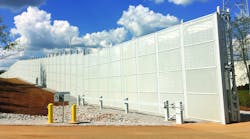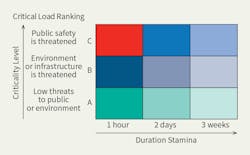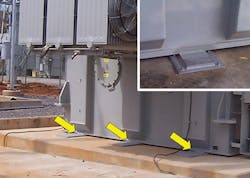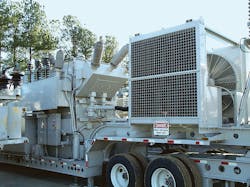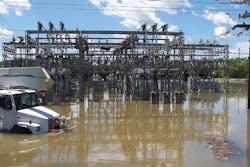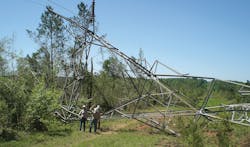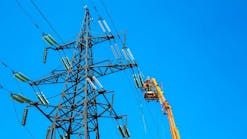In nontechnical terms, resilience is the ability to spring back quickly after an event of any nature that could cause a disturbance to the grid. The location and reach of the Tennessee Valley Authority (TVA) system expose it to a wide range of natural events. Notable past occurrences include a Kentucky ice storm in January 2009, heavy rain in May 2010 that caused a river crest 25.5 ft (7.8 m) above flood stage, and multiple tornados in April 2011. Severe thunderstorms with local strong winds are also common. Although the TVA service area is relatively southerly, solar storms or geomagnetic disturbances (GMD) in 2000 and 2003 caused harmonics, leading to nuisance trips of 161-kV capacitor banks. Although earthquakes are often detected in the New Madrid region at the western end of the TVA grid and in the East Tennessee Earthquake Zone, they continue to be minor.
As public reactions to the power sector’s recovery from hurricanes and, in a different way, Fukushima have shown, expectations are evolving and have become more demanding. A grid is required to provide connectivity to transport power with minimal environmental impacts. The grid must be adaptable to changing types and locations of generation on relatively short notice, and it is required to provide reliable and high-quality power in all circumstances. When extreme events occur, it is expected that the grid will be resilient, that is, recovery must be quick.
Regulatory Activities
Regulatory and legislative agencies are increasingly active. In 2013, several states, including New York, Oregon and Maine, documented expectations relating to emergency planning. The Federal Energy Regulatory Commission (FERC) and North American Electric Reliability Corporation (NERC) also have been active in standards. And within the last three years, the Department of Homeland Security (DHS), Department of Energy (DOE), North American Transmission Forum (NATF), (NIST) and Electric Power Research Institute (EPRI) have all released reports and studies. A follow-up report is also anticipated in 2018 from the reinstated Commission on EMP (electromagnetic pulse).
At the federal level, the FAST Act and the National Defense Authorization Act, both in 2016, and the DOE Final Rule on Grid Security Emergency Orders of January 2018 anticipate federal control of the grid in a national emergency. In addition to regulatory actions, power utilities are seeing increased interest in alternative supplies such as microgrids. While microgrids would not seem to be more resilient or reliable than the grid, their small size may provide an alternative to a backup or emergency supply.
Resilience Matrix
In October 2014, NATF and EPRI proposed a matrix approach to overcome the difficulties of discussing risks without a framework. For each natural or man-made hazard, the matrix would document information on assessment, prevention and hardening measures, detection and monitoring, as well as recovery and restoration. This would facilitate comparisons and enable superior practices to be identified and research topics defined to fill knowledge gaps.
TVA adopted the proposed format, expanding the risk categories to 12 and increasing the categories of information to 11, ranging from a basic description of the risk phenomenon to identification of subject-matter experts. Once the format was established, it took approximately six months to complete the information for all risks. The benefits of the matrix became increasingly clear as the material developed. First, it became an excellent repository as a single point location for documents, reports and reference material that might otherwise be hard to find in different locations. Second, it serves as an excellent resource for educating new employees about past and present risk assessments and responses. Third, although not intended as a primary reference, it provides a useful backup information source in emergency or drill situations.
The matrix has now been complete for more than a year and its first revision is under way. It is not clear whether this should be an annual revision or whether a longer period could be allowed. Clearly as risk and threat discussions expand and risk mitigation thoughts mature, the matrix will provide a format that can be expanded as needed. An example of that is the role communications plays in resilience, and it has become increasingly clear that hardened communications to load centers and power plants is needed along with a tactical system that can be deployed, as needed.
Cyber Threats
The energy sector is an obvious strategic target and reported cyber-attacks on TVA infrastructure are escalating. In 2016, almost 14 billion events were visible against TVA operating technology, of which 491 million were classified as potential security events and more than 54,000 required additional actions. Responses include defense in depth, NERC CIP, NISF/FISMA, and NRC standards, continuous monitoring, security vulnerability scans, equipment review audits, assessments, participation in E-ISAC, and in-house and industrywide incidence response drills.
Earthquake Risks
The New Madrid Seismic Zone has produced extreme seismic activity as recently as 1811-1812. According to U.S. Geological Survey, a similar event has a 7% to 10% probability over the next 10 years. The East Tennessee Seismic Zone also has potential for strong events.
TVA began modifying substation design standards in the 1990s to enhance its survivability by tying down transformers, using seismically qualified equipment and, most recently, reinforcing existing masonry switch houses, including anchorage of roof and relay racks.
GMD and EMP Risks
TVA has been addressing GMD since the early 1990s. Most recently, TVA has installed a network of 12 EPRI Sunburst GIC detectors with plans for real-time displays. This system is being augmented with 12 magnetometers. A system GIC model has been developed and detailed studies performed for NERC benchmark and higher scenarios. Nuisance trips in the early 2000s have been addressed with replacement of vulnerable relays. Since January 2015, there have been 10 GMD storms noted as K5 through K8 events on the EPRI Sunburst system; the maximum GIC measured in 500-kV transformer neutrals at TVA has been less than 17 A. TVA’s entire fleet of 500-kV transformers has been analyzed for GIC-caused VAR and thermal response.
Like other utilities, TVA is actively considering high-altitude EMP as an emerging concern and is working with several partners — EIS Council, DOE, EPRI, National Labs and the EPRI EMP Project begun in 2016 — and benefiting from DHS and DCHIP reports on the very complex issues involved in prevention and recovery. Concrete steps include developing guidelines for practical grid-hardening measures, reviewing black start and emergency plans for EMP scenarios, revisiting existing design practices and upgrading wireless communications systems. TVA’s fiber network will be expanded significantly over the next few years and will include hardening to enable continued use in emergencies. A new operating center will be completed in 2020, and it will be fully shielded and hardened.
Gas-Electric Risk
The polar vortex of 2016 and other cold snaps have focused attention on gas-electric interdependencies. One additional aspect that does not receive widespread attention is that traditional pipeline companies have self-generated their pumping station power, but because of environmental-quality regulations, there is a trend to converting to electric grid supplies for pumping stations. TVA participated in the recent EIPC gas-electric study that considered a range of events for gas-electric interactions within the Eastern Interconnection. As TVA continues its transition to increased gas generation, there have been efforts to identify all pumping stations supplied by the grid and to identify power plants where gas supplies might be affected in the event of grid outages, with the goal of prioritizing restoration of these loads.
Major Equipment Risks
No resiliency plan can succeed without a deliberate analysis of spare equipment needs under various scenarios. Many utility fleets include equipment dating from the 1960s or earlier. Transformers are one of the greatest concerns because of the difficulties of transport and repair. In 2003, TVA established a small set of approved standard transformer designs that provide a high degree of interchangeability. Spare bushings and components for these standard units are also stocked. Additionally, TVA has a mobile transformer fleet and mobile switch houses with racks and portable truck-mounted GIC switchgear. A large transformer oil reprocessing and shipping capability is available to support spare transformer relocations.
Following the tornados of 2011, the consequences of direct tornado hits on 500-kV stations was studied. A gap analysis was performed against existing stocks of spares and indicated the need to purchase additional spares inventory to speed future restoration.
Physical Attack Risk
TVA has done extensive studies to identify critical infrastructure with levels of load or generation loss and stations that could pose a threat to stability of the grid. TVA’s preference is to provide added levels of redundancy that mitigate the risk. TVA is also deploying improved high-speed relays and protection schemes to address the simultaneous loss of substations due to a physical attack. Like other utilities, TVA has been making improvements in physical and process systems for detection intrusion, equipment tampering, card readers, alarm contacts, video monitoring, camera analytics and the use of new cut/climb/ram-resistant fences.
Flooding Risk
In May 2010, 15 inches (380 mm) of rain fell in two days in Middle Tennessee, causing water levels to rise 25 ft (7.6 m) above flood stage. TVA did an evaluation of all substations and switching stations considering 1% annual chance (1 in 100 year) events, 0.2% annual chance (1 in 500 year) events, regulatory floodways, special floodways and maximum probable floods. The goal was to evaluate threats to the bulk grid and evaluate whether local supply stations had adequate redundancy to ensure supply of power if a local station was flooded. A substation that had water over 5 ft (1.5 m) deep was relocated to higher ground.
Storm Risk
Extreme weather events are the traditional emergencies that all utilities have dealt with. Successful response requires a combination of well thought-out design standards (what you expect your system to withstand) and the material inventory, labor and equipment support to enable rapid restoration.
TVA uses records of severe weather with documentation of the emergency material required in each case to restore service as the basis of an emergency stocking plan. Spares are maintained for a limited number of structure types that offer the greatest flexibility for restoration. TVA also stocks supplies of the steel core wire (a long lead item) for common conductor sizes, which can be sent to a conductor manufacturer to speed up delivery of emergency replacements.
Workforce Support
Workforce support is an essential part of an emergency plan. This includes the availability of skilled labor and the ability to house, feed and maintain them in restoration areas. Preagreements with labor organizations, mutual assistance entities and logistical support including fuel sustainability (gasoline, diesel, aviation fuel and propane) become critical. Prelocation of teams and materials in certain conditions where post-storm access may be restricted is also part of the planning.
Recently, TVA participated in a DOE study of scenarios that assume a requirement to replace multiple large power transformers simultaneously. The study helped identify gaps in arrangements for transportation and use of railways and highways. It served as a valuable reassessment of associated capabilities such as oil treatment plants, and provided a basis for recommendations for infrastructure legislation.
Local Power Companies and Community
If a low-probability/very high-impact occurrence damages large portions of the grid, it may be necessary for the public to be able to wait out events at home, thus support of potable water and waste water systems must have a high degree of priority. Community resiliency requires full understanding of critical loads in the local communities and integrating that information into emergency plans. Critical loads also involve some of the other 16 critical infrastructures that pose risks to the public or are needed to support national interests.
Continuing Work
Although a mixed blessing, TVA’s exposure to extreme events and substantial experience in managing natural event recovery has provided a solid basis for resilience. Extreme event planning ensures provision of power to meet the fundamental needs of 9 million consumers.
Grid resiliency activities are factored into TVA regional grid planning studies, and work continues with local power distribution companies to enhance community resiliency. Outreach discussion and collaboration with state emergency services have been in effect for several years and will ensure coordination in the event of emergencies. Committed investments to resilience include enhancement of communication with generating plants and load centers, enhanced grid visibility during emergency operations, upgraded and hardened communications systems, and a new hardened operating center. ♦
Clayton Clem is vice president of transmission strategic projects and initiatives at TVA. He is responsible for several projects, including grid-resiliency initiatives across TVA’s system, and also heads continuous improvement initiatives that include streamlining TVA’s transmission assets with a focus on bulk electric reliability and inventory initiatives to support emergency operations. He holds a BSCE degree and an MSE degree (mechanical) and is a licensed professional engineer in the state of Tennessee. He has 39 years of experience in the power industry and is an ASCE-SEI Fellow.
Ian S. Grant is a planning coordinator for TVA in the transmission engineering department. He previously held positions at The Electricity Commission of NSW in Australia, General Electric Co. and Power Technologies Inc. He has more than 50 years of experience in the power industry and has authored more than 50 professional publications. He is an IEEE Fellow and a CIGRE Distinguished Member.
